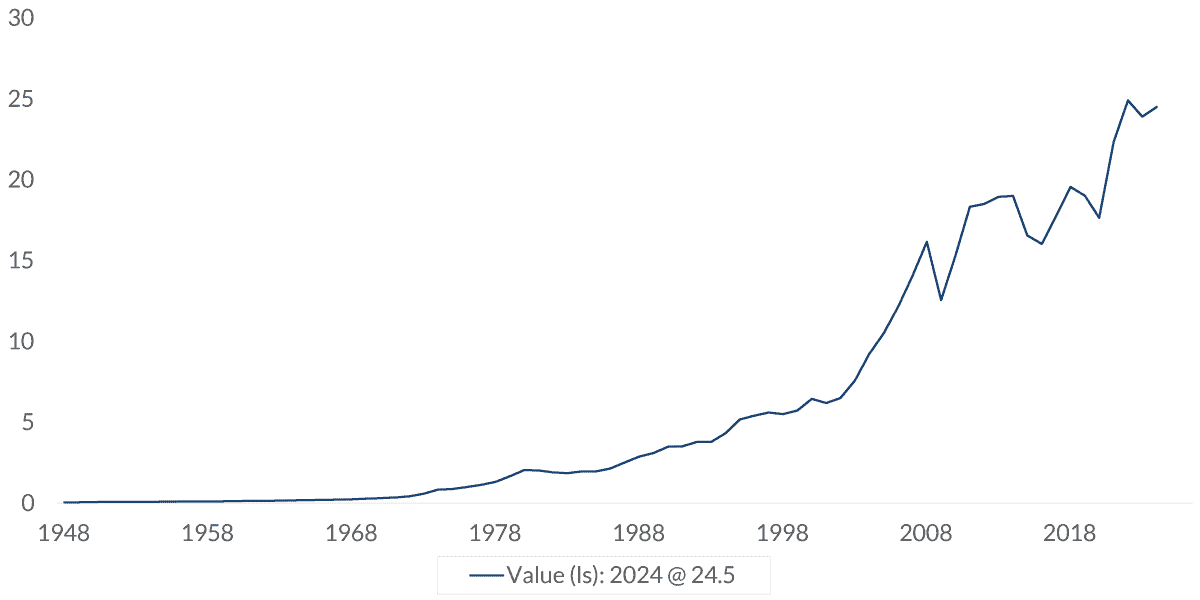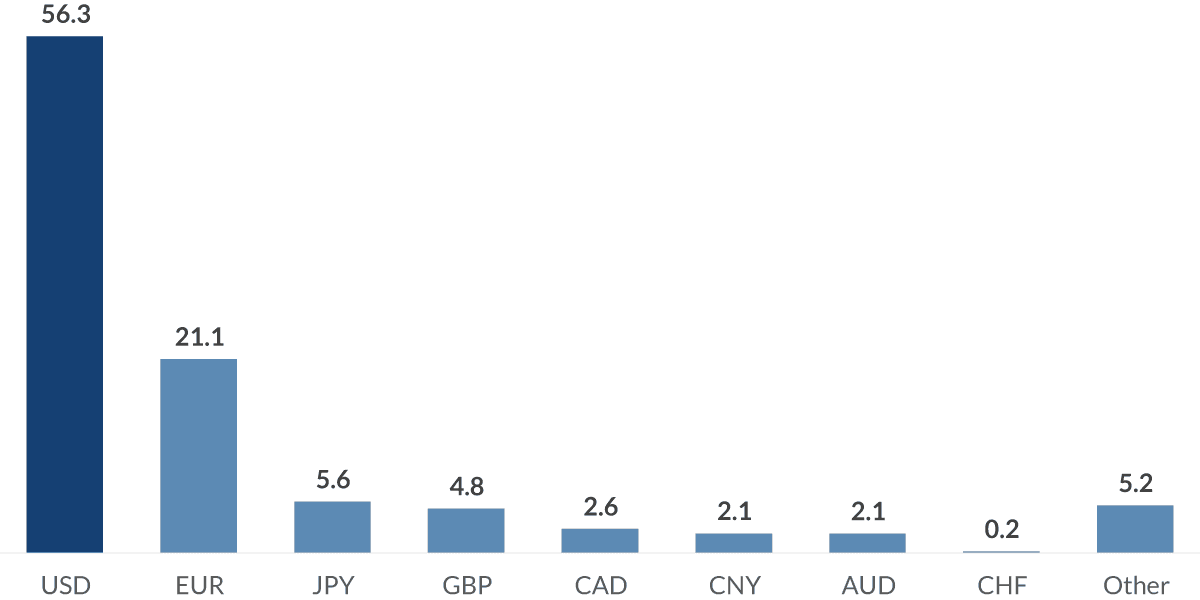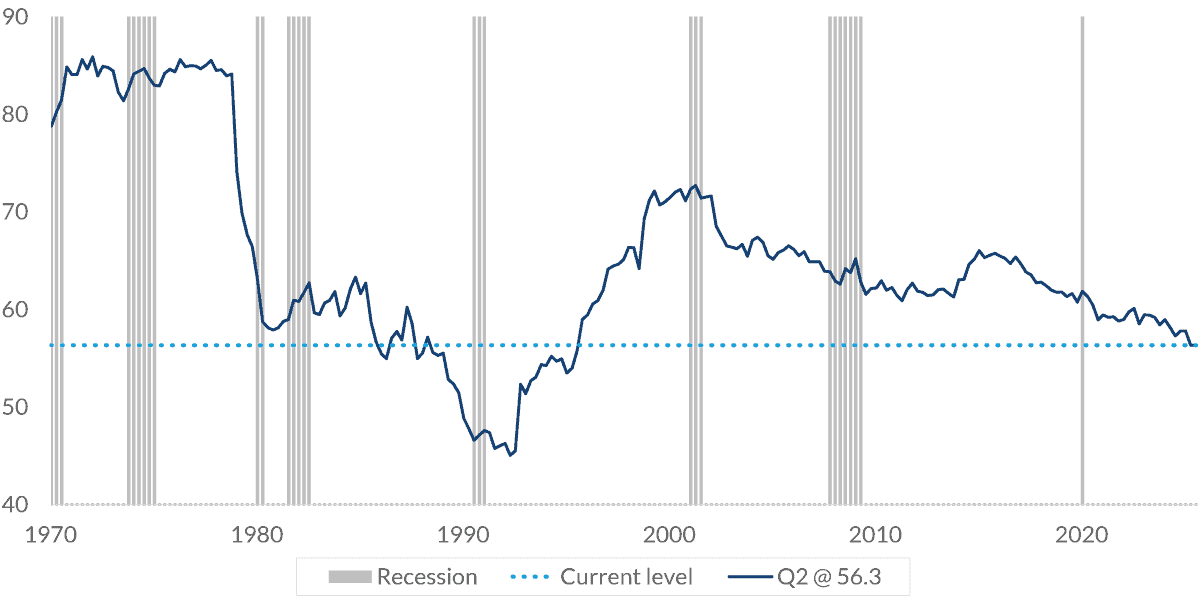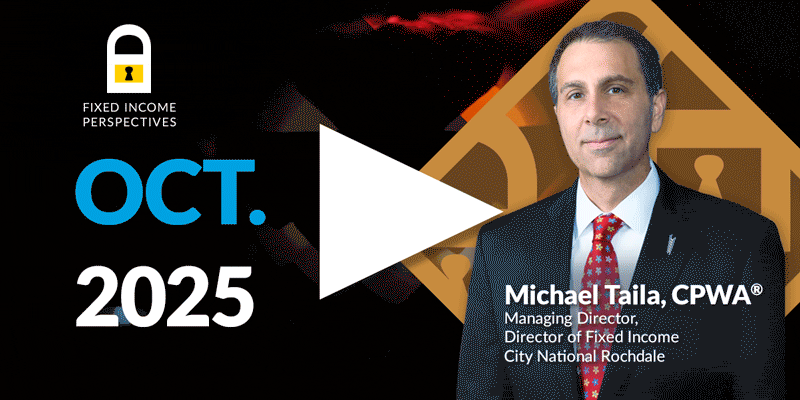-
Economic Perspectives
Foreign Reserves: The U.S. Dollar is Still King
October 2025
- Filename
- Economic Perspectives OCTOBER 2025.pdf
- Format
- application/pdf
TRANSCRIPT
With the value of the dollar fluctuating earlier in the year and the price of gold moving above $4,000 per ounce, we are receiving many questions about the dollar and its status as the premier reserve currency. Much of the discussion of the dollar’s reserve status revolves around numerous geopolitical issues, which are also a significant concern for many investors. The purpose of a reserve currency is to facilitate global trade. Let’s take a look at some charts.
World Merchandise Trade
USD, trillions at current prices

Data current as of October 20, 2025.
Source: United Nations on Trade and Development
Information is subject to change and is not a guarantee of future results.
Chart 1, 0:44– As you can see, international trade has been on an upswing. This has especially true in the past few decades. World merchandise trade is close to $25 trillion per year, almost four times larger than it was in 2000. The increase in trade has also been helped by the U.S. Navy patrolling sea lanes and ensuring safe passage of ships, the invention of the shipping container and the reduction of tariffs.
A key tenet of international trade is that the seller is paid a fair price for its exports. A large share of exporting countries cannot receive payment in their currency from the importing country. Thus, there is a need for a central bank to facilitate the currency conversion. Central banks around the world will hold government securities to ease that process, reduce market volatility and minimize exchange rate risk associated with those transactions.
Foreign Exchange Reserves
% of allocated foreign exchange reserves as of 2025: Q2

Data current as of October 20, 2025.
Source: International Monetary Fund.
Information is subject to change and is not a guarantee of future results.
Chart 2, 1:46– The International Monetary Fund (IMF) recognizes eight major reserve currencies. The U.S. dollar is the most held, making up the vast majority, at 57%.
Foreign Exchange Holdings in U.S. Dollars
% of total

Data current as of October 20, 2025.
Source: International Monetary Fund.
Information is subject to change and is not a guarantee of future results.
Chart 3, 1:58– This chart illustrates the fluctuating usage of the U.S. dollar as a reserve currency. The sharp decline in the late 1970sresulted from most currencies becoming fiat currencies; they were no longer linked to the value of gold. As a result, governments looked to diversify their risk away from the United States’ monetary and sanctions policies that were roiling the financial markets back then, and they were developing their own financial market infrastructure.
Since the 1990s, the use of dollar-denominated foreign reserves has increased, mainly due to the strength and stability of the currency and the economy.
For some historical context, the U.S. dollar being the prominent reserve currency dates back to the Bretton Woods Conference of 1944, which established rules for the monetary order of the postwar global world. The U.S. economy was by far the largest in the world, controlling more than half of the world's gold.
The new rules made payment for international trade efficient, which was a significant goal of the conference. The policymakers wanted to avoid the policy mistakes of the Treaty of Versailles after World War I, which led to isolationism, imposing high tariffs and a high level of tension among neighboring countries. Conference members that believed the economic efficiencies of international trade would encourage stronger relationships among nations and reduce the risk of future conflict.
In the early 1970s, global currency links to gold began to be severed. Even with that, the United States dollar has remained the world’s foremost reserve currency. This is due to the stable value of the currency, the size of the economy and its capital markets — both of which are the largest in the world — and, of course, the country’s geopolitical heft.
It is important to note that the dollar’s role in the international payment system should not be taken for granted. The U.S. economy has significantly benefited from that role, such as when other countries buy U.S. Treasury debt, which helps lower the yield, allowing the government to finance its debt at a lower cost.
Over the years, there have been numerous articles written about concerns regarding dollar dominance, most recently following the Global Financial Crisis, the COVID pandemic and the beginning of this year, but that has not happened.
Now, there are financial and geopolitical incentives for other countries to dethrone the U.S. from its role. That said, it would be difficult for them to do so. Among these are BRICS countries — an acronym for Brazil, Russia, India, China and South Africa. For years, they have discussed creating a new, shared currency. That is not really feasible due to many structural challenges, including weak monetary policy and central banks that are highly influenced by political leadership.
There is also China. Although it is the world’s second-largest economy, it accounts for just 2% of global reserves. That said, China has had some success in using its currency in bilateral international transactions, but that is it.
The most significant risk China poses to international acceptance [of its currency] is that becasue it's a controlled currency; the government regularly intervenes to manage its value for its own benefit. Also, China has capital controls, so there are restrictions on the flow of money into and out of the country, which is very unappealing to those in international trade. Additionally, China limits the amount of bonds that foreigners can hold, and reserve currencies tend to be held in government bonds rather than currency (to collect interest payments).
Countries using the euro — the currency of 20 of the 27-member European Union — are often referred to as the eurozone. These member states have a combined GDP second to the United States and have the second-most-used reserve currency, making up about 21% of the total foreign exchange reserves. Furthermore, their central bank, the European Central Bank, is strong, and their financial markets are liquid and robust. The problems are that there are twenty separate treasury departments with twenty different issuers of debt, resulting in no unified debt market, and their goals favor their own sovereignty, not necessarily the eurozone, making it unappealing to those involved in international trade.
The dollar is still king today, despite all these recent challenges. It remains the currency of choice for global trade. No other currency comes close. To us, there is minimal risk of it being dethroned as the prominent reserve currency.
Important Information
The views expressed represent the opinions of City National Rochdale, LLC (CNR) which are subject to change and are not intended as a forecast or guarantee of future results. Stated information is provided for informational purposes only, and should not be perceived as personalized investment, financial, legal or tax advice or a recommendation for any security. It is derived from proprietary and non-proprietary sources which have not been independently verified for accuracy or completeness. While CNR believes the information to be accurate and reliable, we do not claim or have responsibility for its completeness, accuracy, or reliability. Statements of future expectations, estimates, projections, and other forward-looking statements are based on available information and management's view as of the time of these statements. Accordingly, such statements are inherently speculative as they are based-on assumptions which may involve known and unknown risks and uncertainties. Actual results, performance or events may differ materially from those expressed or implied in such statements.
All investment strategies have the potential for profit or loss; changes in investment strategies, contributions or withdrawals may materially alter the performance and results of a portfolio. Different types of investments involve varying degrees of risk, and there can be no assurance that any specific investment will be suitable or profitable for a client's investment portfolio.
© 2025 City National Bank. All rights reserved.
Stay Informed.
Get our Insights delivered straight to your inbox.
Check out previous perspectives:
Put our insights to work for you.
If you have a client with more than $1 million in investable assets and want to find out about the benefits of our intelligently personalized portfolio management, speak with an investment consultant near you today.
If you’re a high-net-worth client who's interested in adding an experienced investment manager to your financial team, learn more about working with us here.



